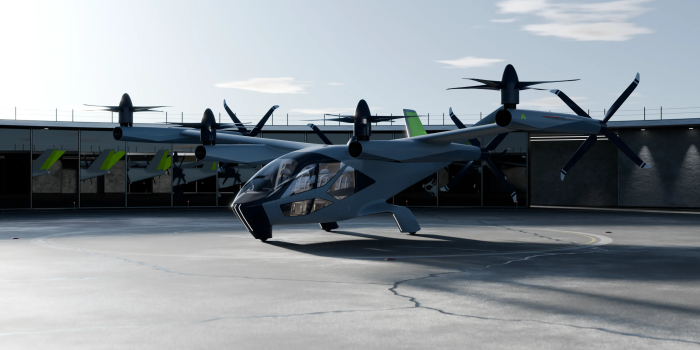Hyundai’s venture into electric vertical takeoff and landing (eVTOL) vehicles takes a significant leap with the unveiling of the S-A2 concept by its subsidiary, Supernal, at CES 2024.
Supernal’s S-A2 eVTOL concept promises to redefine short-distance air travel with a cruise speed of 120mph and an altitude reach of 1,500 feet. The compact yet powerful design accommodates battery capacity suitable for 25- to 40-mile trips, aligning with the typical routes between downtown areas and airports for affluent travelers.
One of Supernal’s key selling points is the emphasis on a noise-free experience, with the S-A2 anticipated to “operate as quietly as a dishwasher.” During vertical takeoff and landing, it emits 65 decibels, significantly lower than the average helicopter’s 96 to 107 decibels. Noise reduction, coupled with eliminating pollution, underscores electric aircraft’s environmental advantages.

With eight tilt rotors and an egg-shaped cabin, the S-A2’s design shares similarities with other air taxi prototypes from industry players like Joby Aviation, Wisk Aero, and Archer Aviation. The shared vision among these companies is to replace traditional helicopters and regional aircraft with eco-friendly, all-electric vehicles designed for short-distance travel.
Initially labeled as “flying cars,” these eVTOLs have since embraced new nomenclature, such as urban air mobility, advanced air mobility, and air taxis. The shift reflects a maturing industry navigating through regulatory processes and testing procedures and overcoming challenges that have led to the closure of some startups, including Larry Page’s Kitty Hawk.

Supernal’s alliance with Hyundai positions it advantageously in terms of manufacturing capabilities, leveraging the automaker’s mass production expertise. However, regulatory approval remains a formidable hurdle, with the Federal Aviation Administration (FAA) requiring three types of certification—type, production, and air carrier—before launching commercial air taxi services.
Supernal addresses the technological challenges by focusing on battery innovations, with plans to adapt to lighter cells as technology advances. Electric flight’s power-to-weight ratio remains a key challenge, and the company’s dedication to upgrading batteries reflects a commitment to overcoming this hurdle.

While grappling with technical intricacies, Supernal envisions a luxurious interior with fine leather upholstery, showcasing a clean and minimal design that creates an impression of spaciousness.
As global companies like Stellantis, United, Delta, Boeing, and NASA also invest in the electric aircraft sector, Hyundai’s Supernal stands poised to contribute to the future of urban air mobility, offering a glimpse into a cleaner, quieter, and more efficient mode of transportation.


